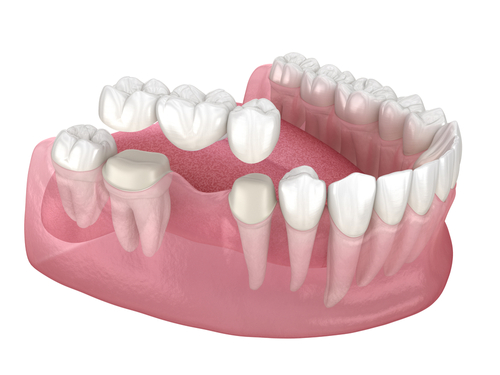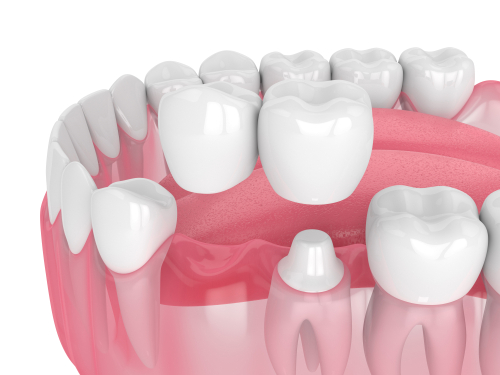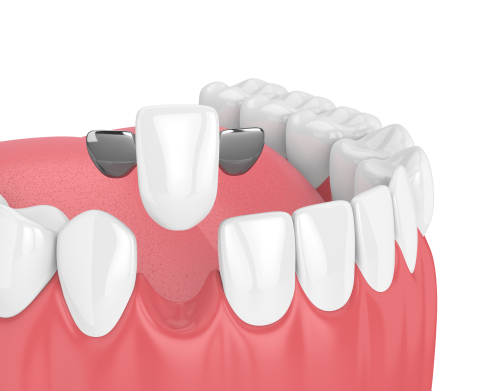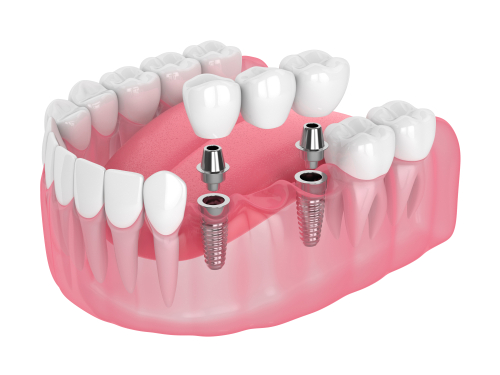Smile Confidently with Dental Bridges
A beaming smile possesses the remarkable ability to brighten any room and leave a lasting impression. However, for those with missing teeth, the assurance to showcase that grin can often waver. Our experienced Hanford, CA dentist, Dr. Jack Nagrani offers dental bridges as a transformative solution, not only providing functional restoration but also delivering a seamlessly natural appearance.
If you’re searching for an effective solution for missing teeth, schedule a consultation with Dr. Nagrani by calling our Hanford, CA dental office at (559) 315-1124.
Types of Dental Bridges
Traditional Dental Bridges
A traditional dental bridge consists of a false tooth or teeth. It is held in place by dental crowns that are cemented onto each of the abutment teeth. These bridges are most frequently employed and typically composed of porcelain fused to metal or ceramics, while cantilever dental bridges may have a similar composition.


Cantilever Bridges
Unlike traditional bridges, which are anchored on both sides of the gap, a cantilever bridge is supported on only one side. This means that the artificial tooth (pontic) is attached to a single natural tooth adjacent to the gap. Cantilever bridges are typically used when there is only one adjacent tooth available for support, making them a suitable option in specific cases.
Maryland Dental Bridges
Maryland dental bridges are widely used to replace a missing tooth, especially in the front teeth area. This type of bridge is also known as a resin bonded bridge. These bridges use a metal framework to sustain itself and do not necessitate dental crowns, unlike cantilever dental bridges that require one supporting tooth. A Maryland dental bridge can only be employed when there is a natural tooth situated on either side of the space created by the absent tooth or teeth.


Implant-Supported Dental Bridges
An implant-supported bridge is a dental prosthesis used to replace multiple missing teeth. Implant-supported bridges are an excellent option for individuals who have lost multiple adjacent teeth but still have sufficient jawbone density to support the implants. Additionally, they can be customized to blend seamlessly with natural teeth, providing a functional and aesthetically pleasing solution for restoring a full and confident smile.
Benefits of Dental Bridges
- Restored Appearance: Dental bridges fill in the gaps left by missing teeth, giving you a complete and natural-looking smile.
- Improved Speech: Missing teeth can affect speech clarity. Bridges help maintain proper tongue placement, allowing for clearer speech.
- Enhanced Chewing Ability: With missing teeth, chewing can become challenging. Dental bridges restore your ability to chew food comfortably and efficiently.
- Prevention of Shifting Teeth: When there are gaps in your smile, adjacent teeth may start to drift or shift. Bridges keep teeth in their proper positions, maintaining your bite alignment.
- Distribution of Bite Force: Bridges evenly distribute the force of your bite across all teeth, preventing excessive strain on individual teeth.
- Maintained Facial Structure: Missing teeth can lead to a sunken appearance in the cheeks and jaw. Bridges help maintain the natural contours of your face.
- Boosted Confidence: Having a complete smile can significantly increase your confidence and self-esteem, making social interactions more enjoyable.
- Simple Maintenance: Caring for a dental bridge is straightforward. Regular brushing, flossing, and dental check-ups are usually all that’s required to keep it in good condition.
- Long-Lasting Solution: With proper care, dental bridges can last for many years, providing a durable and reliable option for tooth replacement.
Candidacy for Dental Bridges
The ideal candidates for dental bridges include those who have:
- Missing one or more teeth that require replacement.
- Good overall oral health with healthy teeth and gums.
- Adequate jawbone structure to support the dental bridge.
- Non-smokers or willing to quit, as smoking can impact the success of the bridge.
- Absence of severe teeth grinding (bruxism).
- Realistic expectations about the appearance and function of the dental bridge.
- Commitment to maintaining good oral hygiene practices.

Dental Bridge Procedure
The dental bridge procedure typically involves several steps:
Initial Consultation
The process begins with an initial consultation with your Hanford dentist. During this appointment, Dr. Nagrani will examine your oral health, assess the condition of the surrounding teeth, and discuss your options for tooth replacement.
Preparation of Abutment Teeth
If the adjacent teeth (abutment teeth) are healthy and suitable for supporting the bridge, they will be prepared. This involves removing a small amount of enamel to create space for the bridge to be placed.
Impression Taking
After the abutment teeth are prepared, impressions of your teeth are taken. These impressions serve as a mold for creating the custom bridge in a dental laboratory.
Temporary Bridge
While the permanent bridge is being fabricated, a temporary bridge may be placed to protect the prepared teeth and restore functionality.
Bridge Fitting
Once the permanent bridge is ready, it is checked for fit and color match. Dr. Nagrani will make any necessary adjustments to ensure a proper fit.
Final Placement
The bridge is permanently cemented onto the abutment teeth. Your Hanford dentist will ensure that the bridge is securely in place and that your bite is aligned correctly.
Frequently Asked Questions
How long does a dental bridge last?
With proper care and regular dental check-ups, a dental bridge can last between 5 to 15 years or even longer. The lifespan may vary depending on factors like oral hygiene, bite force, and material used.
How long does a dental bridge last?
With proper care and regular dental check-ups, a dental bridge can last between 5 to 15 years or even longer. The lifespan may vary depending on factors like oral hygiene, bite force, and material used.
Can I eat normally with a dental bridge?
Yes, once you’ve adjusted to your new bridge, you should be able to eat a wide variety of foods. However, it’s advisable to avoid excessively hard or sticky foods that may put extra strain on the bridge. Initially, you may want to start with softer foods and gradually reintroduce harder ones.
What if my dental bridge feels uncomfortable or loose?
If your dental bridge feels uncomfortable or seems loose, it’s important to contact your dentist promptly. Discomfort or mobility may indicate the need for an adjustment or repair. Avoid trying to fix it yourself, as this could lead to further complications. Your dentist will assess the issue and take appropriate steps to ensure the bridge functions properly.
Embrace a radiant smile with dental bridges!
Dental bridges offer a remarkable solution for those seeking to restore both their smile and confidence. With their natural look and functional benefits, they stand as a testament to modern dentistry’s ability to enhance smiles. If you’re ready to rediscover the joy of a complete smile, don’t hesitate to schedule a consultation with your dentist today by giving our Hanford, CA dental office a call at (559) 315-1124. Take the first step towards a brighter, more confident you – explore the possibilities of dental bridges now!
